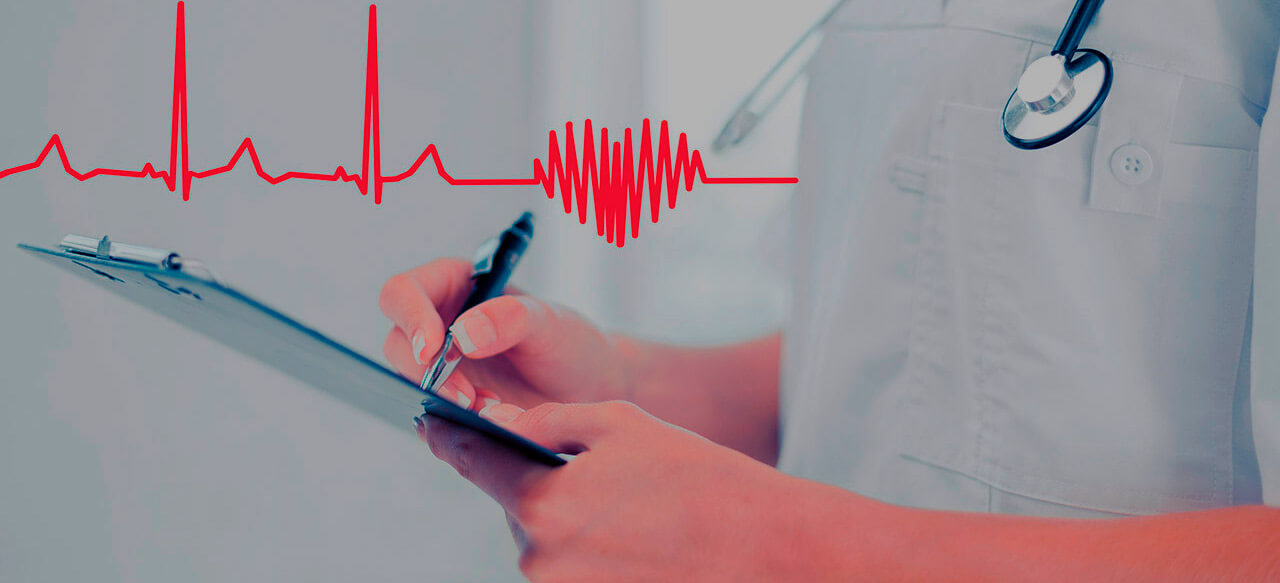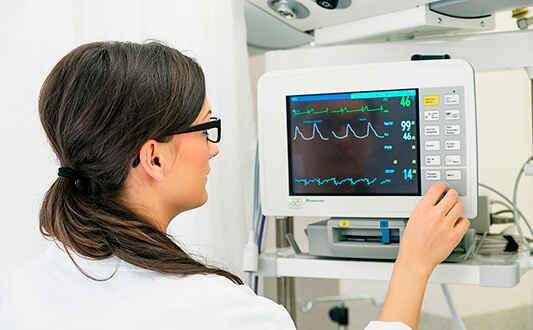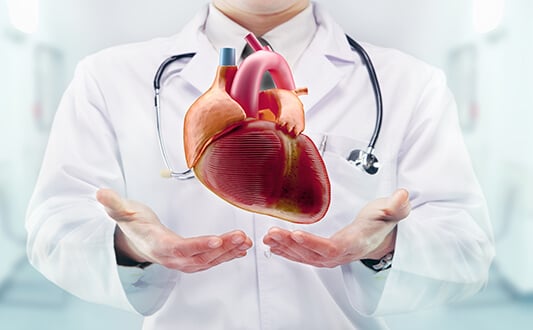Coronary artery disease (CAD), or coronary heart disease, is an extremely widespread condition in the modern world, when the excessive amount of LDL cholesterol in the blood stream damages coronary vessels and causes hypoxia and death of the heart muscle (myocardium). The problem is that at early stages coronary artery disease is asymptomatic. Unfortunately, CAD is often revealed at advanced stages, when angina pectoris, heart failure or myocardial infarction are already present. At early stages a change in lifestyle may be enough for stabilization of the process and improvement of laboratory parameters. Advanced stages of CAD requires drug therapy and surgical interventions. It is crucial to choose the appropriate coronary artery disease care plan and consolidate the result during rehabilitation program. People with CAD can live normal lives without any restrictions if treatment is provided regularly and selected wisely.
Content
- Background of coronary artery disease
- Lifestyle modification and natural treatment for coronary artery disease
- When sole prophylaxis is not enough: medicine intervention
- Going further to surgical treatment: percutaneous transluminal coronary angioplasty
- Solution for the most complicated cases: coronary artery bypass grafting
- Improve the achieved result: rehabilitation programs
- Where may I receive the most effective help?
Background of coronary artery disease
In order to understand the main principles of preventive care and treatment, we should take a closer look at the pathophysiology of coronary artery disease. All organs, tissues and each separate cell in the body needs oxygen to maintain vital activity. The only way to deliver required amount of oxygen to all parts of the body is to transport it through the bloodstream. The heart receives blood rich with oxygen via coronary vessels. We distinguish two main arteries, right and left coronary arteries, and their tinier branches, up to capillaries. Regardless of individual peculiarities, the maximum diameter of coronary arteries is about 8 mm.
The heart consumes oxygen actively enough, as it is working continuously throughout one’s lifetime. Even small changes in the blood supply may become extremely significant for this organ. Atherosclerosis is the most widespread cause, which leads to narrowing of the arteries` lumen and reducing blood supply. When it comes to coronary vessels, atherosclerotic coronary artery disease becomes a potentially life threatening condition.
Atherosclerotic process starts with the impregnation of the vessel`s wall with LDL (low-density lipoprotein) cholesterol. LDL cholesterol is the “bad” part of general cholesterol, which is able to injure the vessels` wall. It should be mentioned, that not all fractions of cholesterol are harmful. For example, HDL (high-density lipoprotein) cholesterol is a protective one and mainly serves as transport substance. Small lipid spots on the surface of vascular wall gradually transform into lipid plaques. Fortunately, this process is prolonged enough and usually takes years, so we have time for preventive measures.
Depending on the stage of the process, plaques in coronary artery disease may be stable and unstable. Unstable plaques have two ways of evolution:
- Resolve. Plaque may decrease in volume or totally disappear spontaneously or due to influence of treatment measures. This is the primary aim of treatment.
- Rupture. If the best happened, rupture may be beneficial and lead to further resolving of residual plaque. In other cases blood vessel is damaged and the blood clots arise, which creates risk of thrombosis. At this point treatment alleviates coronary artery disease symptoms and prevents complications.
Stable plaques in coronary artery disease continue their growth, harden and narrow the lumen of vessels. Once blood supply through these vessels is significantly reduced (usually this happens in 75 % of losing the vessel`s lumen) or totally blocked, heart starts suffering from hypoxia (oxygen deficiency) and complaints arise.
The most common and dangerous coronary artery disease symptoms include the following:
- Angina. This is chest pain associated with coronary artery disease. It may be also described as discomfort or squeezing in the chest, shoulders, back or even lower jaw. Sometimes manifestations are tricky and may lead to misdiagnosis. Angina requires symptomatic treatment and etiotropic therapy – the lowering of the cholesterol level.
- Heart attack is an acute life threatening condition. It arises when part of the heart is totally deprived from oxygenated blood and thus may die. Heart attack requires emergency health care and admission to the hospital for treatment.
- Heart failure and arrhythmias. Continuous oxygen deficiency affects the normal functioning of heart muscle, which results in lower strength and abnormal heart rhythm.
Taking into consideration all aspects of coronary artery disease pathophysiology and stages of the disease, treatment of this condition includes such measures:
- Preventive measures and avoiding risk factors
- Medicinal treatment
- Minimally invasive and surgical treatment
- Rehabilitation programs
Lifestyle modification and natural treatment for coronary artery disease
The most effective way to cope with coronary artery disease is also the thing that requires the least effort and that is prevention. Measures for resolving existing plaques in coronary artery disease and reestablishing blood flow are always associated with side effects and risks, lifelong treatment and are less beneficial in the financial aspect. Prevention is aimed at excluding modifiable (those we are able to change) risk factors and diminishing influence of non-modifiable (those we are not able to change) risk factors.
Surprisingly, preventive measures don`t necessary include medicines. For most patients, especially at the early stages of the disease, implementing lifestyle modifications is generally enough for improving the results of laboratory tests and reducing general risk of severe cardiovascular events (such as acute coronary syndrome and myocardial infarction). Natural treatment for coronary artery disease is popular worldwide and has proven its effectiveness.
Basic lifestyle modification measures for avoiding risk factors include:
- Nutrition changes, adopt a heart-healthy diet. If you want to control your cholesterol level with the help of a diet, you should exclude or restrict products with high content of trans fats, saturated fats and sugar. Also it is better to avoid alcohol, as it causes additional damage of the heart muscle. List of useful products include food rich in omega-3 fatty acids (salt-water fish), unsaturated fats (tofu, seeds and nuts, soybean oil) and fibre (cabbage, whole grains, fruits). You may also use such natural remedies for coronary artery disease, as traditional teas (green or white tea), herbs and spices (curcumin, ginger, cinnamon, basil, thyme). Medical supplements with omega-3 fatty acids and coenzyme Q10 can also be used.
- Weight loss helps in lowering blood pressure, normalizing blood sugar and fighting with insulin resistance. It is closely connected with previous point – healthy eating, and the next one – being physically active. Obesity and coronary artery disease are interdependent, as one condition aggravates another.
- Being physically active. Appropriate physical activity during 30-60 minutes daily significantly improves state of cardiovascular system, increases tolerance to hypoxia, stimulates blood flow through coronary vessels, helps in lowering blood pressure and blood sugar levels, serves as a relaxing measure. You may choose personally your best exercise for coronary artery disease – walking, jogging, swimming, yoga, etc.
- Quit smoking and using other tobacco products. Nicotine worsens the state of vessels, causes high blood pressure level and increases the level of cholesterol in blood and provokes hypoxia in heart muscle. Actually, smoking takes the first place among preventable causes of premature death in USA.
- Managing stress. Continuous negative emotions, especially strong ones, worsens the course of coronary artery disease or can even trigger a heart attack. You can cope with stress with the help of communication with relatives and friends, going in for sports, contributing time to hobbies, learning something new or working with a psychotherapist.
Of course, there are certain non-modifiable risk factors that we can`t control. Such factors include age, gender and family history of coronary artery disease. Presence of non-modifiable risk factors shouldn`t make you give up, it is just a reason for being proactive and paying additional attention to preventive care. To be noted, thorough preventive measures may make your total risk of developing cardiovascular event even lower, than a healthy person has.
When sole prophylaxis is not enough: medicine intervention
In certain circumstances lifestyle modification gives positive results, but they are not sufficient for significant risk lowering. In such situation healthcare professionals will add drugs to your coronary artery disease care plan. This may be monotherapy with one type of drug or combined therapy with few types of necessary drugs. Also medications are always administered after minimally invasive and surgical interventions for coronary artery disease treatment, or after serious complications such as myocardial infarction and heart failure.
Medicinal therapy usually pursues numerous aims, like:
- Cardiovascular events prevention
- Alleviation of coronary artery disease symptoms and improving general state
- Improving quality of life and prolonging life expectancy in patients with coronary artery disease
Optimal medical therapy for coronary artery disease is always strictly individual, as it takes into consideration complaints, results of physical examination, presence of concomitant conditions, results of laboratory tests and instrumental investigations, and other aspects.
Depending on all the available information, doctors will administer one or few drugs for the following purposes:
- To resolve existing plaques and prevent plaque formation in the future. In such a situation you need to have a normal cholesterol level, so a doctor will prescribe you statins (e.g. simvastatin, rosuvastatin). Statins directly remove LDL cholesterol from the bloodstream, so plaque is deprived of building material. In recent decades fibrates, ezetimibe and nicotinic acid were applied for the same purpose, but administration of statins for coronary artery disease was shown to be the most effective measure.
- To prevent blood clotting after plaque rupture or in the postoperative period after surgical interventions. Antiplatelet drugs are used for this purpose, as they don`t allow thrombocytes (also called platelets) to aggregate and form blood clots. Doctor will prescribe you low-dose aspirin; other variants are clopidogrel and ticagrelor.
- To ease symptoms during angina pectoris episode. In such cases doctor prescribes drugs that widen vessels and decrease oxygen demands of heart muscle. These drugs are called anti-anginal drugs; they include nitrates in different forms (tablets, spray, plaster), β-blockers and calcium channel blockers. Nitrates are always used as first-aid drugs for coronary artery disease during angina episodes.
- To normalize blood pressure. Arterial hypertension is a serious risk factor of cardiovascular episodes development. Antihypertensive drugs should be taken daily, under strict control of blood pressure level. This group of drugs includes β-blockers, angiotensin-converting enzyme inhibitors, angiotensin II receptor blockers, calcium channel blockers and diuretics.
- To normalize blood sugar. Diabetes and coronary artery disease are often accompanied by each other. Decompensated diabetes mellitus significantly increases risk of heart attack and myocardial infarction development. Along with dietary recommendations doctors will prescribe you drugs that stimulate the pancreas, increase sensitivity of tissues to your own insulin or directly remove glucose from the body.
- To normalize body mass. First priority measures in body mass normalization are diet and physical activity; drug therapy is only an additional intervention. Drug therapy for such cases includes medicines for appetite suppression and removing food fats from the body without digestion.
Medicinal therapy is provided only under close medical supervision, as it needs to be constantly adjusted in accordance with changes in general state and laboratory tests results.
Going further to surgical treatment: percutaneous transluminal coronary angioplasty
When coronary artery disease symptoms persist regardless of lifestyle modification and medicinal treatment, doctors may advise you to mechanical remove the plaque to relieve coronary artery disease manifestations. The first, minimally invasive way to do this is to perform percutaneous transluminal coronary angioplasty (PTCA).
Full list of indications for PTCA performing includes:
- Progressive angina pectoris, when coronary artery disease symptoms worsen despite all kinds of medicinal treatment, or stable angina pectoris with low quality of life
- Heart attack, which may be acute coronary syndrome or myocardial infarction (but only early stages)
- Constant episodes of angina pectoris after old myocardial infarction
- High risk of cardiovascular events based on the results of examination and clinical history
Percutaneous transluminal coronary angioplasty, or percutaneous coronary revascularization, is performed under the local anesthesia. Beyond all doubt, you will go through the standard examination before the surgery for coronary artery disease: laboratory tests, ECG, discussing allergic reactions to iodine and latex, adjustment of previously taken medications (e.g. warfarin, insulin). The process is controlled by CT / MRI with contrast, but qualification of the surgeon has primary importance, as the procedure involves coronary arteries with a maximum size of 8 mm. During PTCA thin flexible catheter with the balloon on the end is put into the groin artery and moved along the vessels to reach the affected region of coronary artery. Once the catheter is near narrowed or blocked segment, the balloon is inflated and plaque is mechanically destroyed – compressed against the vessel wall. The next step is deflating the balloon and removing it from the vascular system. Finally, blood flow restores back to normal; complete healing of the vessel`s wall after the surgery for coronary artery disease takes 2-3 weeks.
In most cases PTCA is not restricted only to removing plaque with the help of the balloon, this manipulation is followed by stent placement. Stent for coronary artery disease treatment is a hollow metal tube, which is put in the narrowed or blocked zone of artery. Stent percutaneous transluminal coronary angioplasty is more effective in long-term scape, as it has lower risk of recurrent stenosis.
The intervention begins in the same way and the stent is moved along the artery in a compacted state. In the targeted zone the stent is expanded with the help of an inflated balloon and tightly covers vessel`s wall after balloon deflating. Thus, the narrowed zone of the artery is completely restored, as in patients with coronary artery disease stent placement protects vascular wall during long periods of time.
The first stents were metal, without any additional substances, which resulted in relatively high risk of repeated stenosis (it reached 25 % during the first 6 months after the intervention). Nowadays we have more advanced drug-eluting stents covered with antiproliferative drugs, which prevent restenosis and suppress scar tissue formation near the stent. Drug-eluting stents significantly reduce risk of restenosis and are especially beneficial in patients with high risk – people with diabetes mellitus and genetic disorders of cholesterol metabolism. In addition, new stents` inner coating is similar to the one inside the artery. Stents can even be dissolving, if such coronary artery disease care plan is the most favorable for the patient.
There are options of mechanical plaque removing without stent placement, like rotablation, atherectomy and cutting balloon, but they appear to be more traumatic and less effective compared to the stenting procedure. You will continuously take drugs to control blood pressure level and prevent restenosis after all kinds of angioplasty.
Solution for the most complicated cases: coronary artery bypass grafting
Unlike PTCA, coronary artery bypass grafting (CABG) in patients with coronary artery disease is an invasive open heart surgery. Before CABG performing blood vessels are taken from other parts of the body (usually veins from legs or arteries from forearm and chest wall are used) to create a new route of blood flow around narrowed or completely blocked segments of the heart arteries. During the procedure one end of the graft is connected to the aorta and other – to the affected coronary artery below non-functioning part. Thus, the blocked segment is not diminishing blood flow any more, as the alternative route for blood is functioning.
CABG indications in patients with coronary artery disease are similar to PTCA ones, but not restricted to them. Additional clinical conditions, when CABG is suitable, include:
- Too tight narrowing of the vessel, when successful stent placement is impossible (usually it concerns narrowing up to 2 mm in size)
- Presence of multivessel coronary artery disease, when 1-3 stents placement is not enough to improve patient`s state
- Location of the narrowing near the artery flexure
- Repeated restenosis of stents, especially in high-risk patients
CABG procedure is constantly modified and improved, as it is the most comprehensive and radical option in the coronary artery disease care plan.
Today there are three main variants of CABG:
- Traditional CABG, the open heart surgery, when the heart is stopped with the help of medicines and a surgeon is operating on the still heart. During the traditional CABG heart-lung machine is responsible for maintaining the vital activities.
- Off-pump CABG, the open heart surgery, when the heart is not stopped. This kind of surgery is performed on the beating heart, which recovers faster and lowers the risk of side effects.
- Minimally invasive direct CABG. This is a new approach without opening the chest bone. Manipulation is performed via few small cuts in the left part of the chest between the ribs. Minimally invasive direct CABG allows to reach vessels on the anterior surface of the heart; it suits for a few-vessels procedures.
Approximate duration of CABG in patients with coronary artery disease is 3-4 hours and you will need to stay in the hospital during 5-7 days after the operation. Complete healing of the breastbone takes up to 8 weeks, so physical activity may be limited for this period. You will receive long-lasting preventive drug treatment, as there is certain risk of plaque growth in a graft.
Improve the achieved result: rehabilitation programs
Rehabilitation is a complex of measures for primary and secondary prevention of coronary artery disease, restoring affected functions after the stage of active treatment and living comfortably with the disease.
Therefore, patients benefit from CAD rehabilitation started:
- After the first episodes of angina pectoris
- After heart attack or myocardial infarction
- In the postoperative period after angioplasty or CABG
Rehabilitation is a medically supervised program, during which you will be treated by a team of specialists. Professional rehabilitation team usually includes cardiologists and doctors of related specialties, nurses, physiotherapists, nutritionists and psychologists. Rehabilitation programs meet the many-sided requirements and are not restricted to sole medical aspects. The main aims of work with patients include improving the quality of life, alleviating coronary artery disease symptoms, restoring usual activities and reducing the risk of relapse developing.
Coronary artery disease care plan is always individually focused, as rehabilitation programs are constantly adjusted according to changing demands of the patient.
General parts of the program, common for all cases, are the following:
- Learning theoretical information. When you understand causes of the disease and its pathological mechanisms, you will also successfully understand ways of fighting it. Knowledge gives you the confidence and strength to cope with coronary artery disease symptoms.
- Practical part. This part includes physical exercises, working with a psychologist, consultation of doctors, etc.
- Tracking changes in the state. This part includes general examination by your doctor, laboratory and instrumental tests.
Rehabilitation program is not something you may forget once you return home from the hospital. This program gives you all tools for maintaining and improving the state of your health constantly.
Where may I receive the most effective help?
Coronary artery disease treatment requires help of qualified healthcare professionals at each stage. It is quite obvious, that correct preventive measures may substantially postpone the administration of drugs, and individual and thorough drugs prescribing postpone surgical interventions. In addition, rehabilitation programs are suitable at any stage of treatment. The only common feature of all kinds of treatment for coronary artery disease is decent qualification and experience of healthcare professionals. Doctors should be really keen on understanding the most intricate details of coronary artery disease pathophysiology, be familiar with the latest achievements in the field of medicinal treatment and have impressive experience in performing surgical procedures.
Nowadays people with atherosclerotic coronary artery disease often choose treatment abroad, as it is possible to apply for a treatment program in the most developed countries with outstanding level of medicine. When it comes to the treatment of cardiologic disorders, Germany takes one of the leading positions in terms of conservative treatment, surgical interventions and comprehensive rehabilitation programs. Information about cardiologic surgeons and specialists in conservative treatment is available online, as well as stories of successfully treated patients, so choosing between best of the best may become a real challenge. Next important moment is ability to come for consultation, surgical management of coronary artery disease or rehabilitation program timely, as good specialists always have certain waiting list with the priority to patients from their native country.
Taking into consideration all these details, the most suitable variant of arranging medical program abroad is using the help of the company Booking Health. Booking Health is the medical tourism company, which annually helps thousands of cardiology patients with treatment abroad. Patients with early stages of coronary artery disease come for check-ups and preventive treatment recommendations, patients with advanced stages of disease and numerous complications seek for surgical treatment and rehabilitation.
Booking Health manages such significant aspects of treatment abroad, as:
- Recommending the best doctor and clinic for your case
- Booking an appointment on the convenient date
- Organizing a comprehensive check-up program and proceeding to surgery, if necessary
- Providing you with transfer, an interpreter and a medical coordinator, if necessary
- Providing you with obligatory medical insurance, which is extremely important in case of surgical management of coronary artery disease
- Preparing for you all the medical reports and further recommendations
- Providing help in further cardiology rehabilitation, if necessary
- Providing help in further communication with your treating physician
To arrange your medical program you should leave a request on the website of Booking Health. Our reliable case manager or medical advisor will contact you the same day to discuss all the details. We will help you in reaching the best decision regarding all medical and organizational aspects of your journey.
Choose treatment abroad and you will for sure get the best results!
Authors:
The article was edited by medical experts, board certified doctors Dr. Vadim Zhiliuk, Dr. Sergey Pashchenko. For the treatment of the conditions referred to in the article, you must consult a doctor; the information in the article is not intended for self-medication!
Sources:
National Center for Biotechnology
JAHA - Journal of the American Heart Association
Read:
Cardiac surgery in Germany – modern treatment of heart disease
Don't know where to start?
Contact Booking Health







